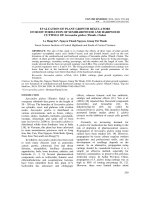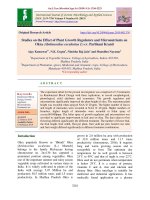Evaluation of plant growth regulators on root formation of semihardwood and hardwood cuttings of Sarcandra glabra (Thunb.) Nakai
Bạn đang xem bản rút gọn của tài liệu. Xem và tải ngay bản đầy đủ của tài liệu tại đây (1.35 MB, 8 trang )
TAP CHI
Evaluation
SINH HOC
of plant
2016,
growth
38(3):
regulators
359-366
DOI:
10.15625/0866-7160/v38n3.7843
EVALUATION OF PLANT GROWTH REGULATORS
ON ROOT FORMATION OF SEMIHARDWOOD AND HARDWOOD
CUTTINGS OF Sarcandra glabra (Thunb.) Nakai
Le Hong En*, Nguyen Thanh Nguyen, Giang Thi Thanh
Forest Science Institute of Central Highlands and South of Central Vietnam
ABSTRACT: The aim of this study is to evaluate the effects of three types of plant growth
regulators (α-naphthyl acetic acid, indole-3-acetic acid and β-indol butyric acid) on the root
formation of the semihardwood and hardwood cuttings of Sarcandra glabra (Thunb.) Nakai. The
effects of plant growth regulators on root formation were evaluated based on living percentage,
rooting percentage, secondary rooting percentage, and the number and the length of roots. The
results showed that the best root growth regulator was β-IBA. The overall effective concentrations
of growth regulators were 1.0 and 1.5%. The living percentage of the semihardwood cuttings was
lower than that of the hardwood cuttings. However, the root growth parameters of the
semihardwood cuttings were better than those of the hardwood cuttings.
Keywords: Sarcandra glabra, α-NAA, IAA, β-IBA, cuttings, plant growth regulators, root
formation.
Citation: Le Hong En, Nguyen Thanh Nguyen, Giang Thi Thanh, 2016. Evaluation of plant growth regulators
on root formation of semihardwood and hardwood cuttings of Sarcandra glabra (Thunb.) Nakai. Tap chi
Sinh hoc, 38(3): 359-366. DOI: 10.15625/0866-7160/v38n3.7843.
*Corresponding author:
INTRODUCTION
Sarcandra glabra (Thunb.) Nakai is an
evergreen subshrub that grows to the height of
50 - 150 cm. The branches of Sarcandra glabra
are cylindric, erect, and glabrous with swollen
nodes. Sarcandra glabra is distributed in
various environments such as forest, valleys,
ravines, slopes, roadsides, trailsides, grasslands,
swamps, streamside, and sandy soil of from
near sea level to 2,000 m. Sarcandra glabra is
distributed wildly from Southeast Asia to India
[18]. In Vietnam, this plant has been cultivated
in some mountainous provinces such as Lang
Son, Bac Can, Thai Nguyen, Ninh Binh, Quang
Nam, Kon Tum and Lam Dong [5].
In folklore, Sarcandra glabra has been used
to treat many diseases such as pancreatic
cancer, gastric, colorectal, liver and throat
diseases, encephalitis, bacillary dysentery,
appendicitis, boils, bone fractures, arthritis, and
backache [1, 3, 9]. Several pharmaceutical
components such as isofraxidin, fumaric acid,
chloranthalactone and sesquiterpene lactones
have been identified from this plant [17].
Isofraxidin has anticancer and cholagogic
effects, whereas fumaric acid has antibiotic,
antalgic and antitumor effects [11]. Yen et al.
(2010) [16] reported that, flavonoid compounds
(tectoridin)
and
hexandrin
(1β,
28dihydroxylup-20
(29)
en)
could
be
extracted from S. glabra. This inceptive finding
promoted further studies about S. glabra
extracts on the inhibiton of cancer cells growth
in vitro.
Currently an increasing demand for
S. glabra for medication has been leading to the
risk of depletion of pharmaceutical sources.
Propagation of Sarcandra glabra using tissue
culture have been studied [18, 19]. However,
propagation by tissue culture requires modern
equipments and professional staffs, and the
development of seedlings depends on the
season. As an alternative, propagation using
cuttings should be considered because it is a
simple yet effective method, especially for
minority communities, to preserve this precious
medicinal source. In Anhui Province, China,
propagation of S. glabra using cuttings was as
high as 80% of rooting percentage [8, 12].
However, there were limited studies about
359
Le Hong En et al.
factors affecting propagation of S. glabra using
cutting techniques. Therefore, in this study, we
aimed to evaluate the effects of the plant growth
regulators on rooting of two types of Sarcandra
glabra cuttings, semihardwood and hardwood
cutting.
MATERIALS AND METHODS
Study location
The experiment was conducted in the
greenhouse of the Department of Seedling and
Biotechnology, Forest Science Institute of
Central Highlands and South of Central
Vietnam, located at Da Lat city, Lam Dong
province, Vietnam. The average annual
temperature ranges from 18 to 25oC. The
average annual rainfall of this region is 2,200
mm, where 80-90% of annual rainfall is
received during rainy season of May to
November.
Samples collection
The branches of Sarcandra glabra were
collected from Bidoup - Nui Ba Natinal Park
during rainy season. Then, they were cut into
segments with a length of approximately 15 cm.
Two types of cuttings, semihardwood and
hardwood cuttings were used. Semi-hardwood
cuttings were taken from parts of the tree where
the lower portion of the cutting had lignified.
They were taken 3 weeks after collection of
softwood cuttings, which were parts of the tree
where the wood was still soft, succulent and the
wood had not yet lignified. Hardwood cuttings
were taken from fully matured parts, where the
entire stem had lignified.
Plant regulators treatment
Three plant growth regulators: α-NAA (αnaphthyl acetic acid), IAA (indole-3-acetic
acid) and β-IBA (β-indol butyric acid)
(MERCK®, Germany) were used in this study.
The concentrations tested for growth regulators
was 0; 0.5; 1.0; 1.5 and 2.0% (w/w). α-NAA,
IAA, and β-IBA were dissolved in a small
quantity of alcohol, and then were mixed with
talc to form a slurry. The slurries were allowed
to dry with gentle heat to evaporate the alcohol
and then were grounded and passed through a
sieve. The collected powders of each plant
360
growth regulators were used for the plant
growth experiments.
Experimental design
Factorial arrangement of treatments on the
basis of randomised complete block design was
used as the experimental design: 2 kinds of
cutting types; 3 plant growth regulators (PGRs),
each with 5 concentrations with 3 blocks
(replications) and 30 cuttings per treatment per
block. The experiment was conducted on sand.
Observation
analysis
recording
and
statistical
All cuttings were harvested 75 days after
treatment and the following data were recorded:
the living percentage (%), rooting percentage
(%), secondary rooting percentage (%), the
number of roots, and the length of roots (cm).
The statistical analysis was performed with
SPSS 16.0 (Statistical Package for Social
Sciences version 16) software using Duncan’s
range tests.
RESULTS AND DISCUSSION
Effects of plants growth regulators on two
types of cuttings of S. glabra were determined
using various plant growth parameters and are
presented in table 1. The results showed that
there was significant difference in rooting
percentage between the two cutting types.
Statistical differences of rooting percentage,
secondary root percentage and number of roots
were also found between three different types of
PGRs. Besides, concentrations of PGRs also
caused differences in rooting percentage,
secondary root percentage and length of roots.
The interactions between the three variables and
between PRGs and their concentration only
caused significant difference in secondary root
percentage. In the other hand, there were
interactions of cutting types x PGRs and cutting
types x concentration on both rooting
percentage and secondary root percentage.
Overal, the statistical analysis indicated that
cutting types had the most important impact on
plant growth parameters. Details of the effects
of each variable are presented in table 2, 3 and 4
and further dicussed below.
Evaluation of plant growth regulators
Cuttings types are classified into softwood,
semihardwood and hardwood based on their
maturity [4]. Root growth is affected by cuttings
types and species of plants. For example,
Yeshiwa et al. (2015) [15] reported that, in case
of roses, the hardwood cuttings showed better
root growth than softwood and semihardwood.
In case of Himalayan yew, Taxus wallichiana,
semihardwood has better growth than softwood
and hardwood [13]. In this study, however,
softwood cuttings were excluded because of the
high frequency of immature death. The present
results showed that all root growth parameters
of the semihardwood cuttings was significantly
(P<0.05) better than the hardwood cuttings
(table 2). Thus, semihardwood cuttings were
recommended for breeding production. Apart
from rootings, hardwood cuttings had higher
survival rates and should be further studied to
have better conclusion.
Table 1. Tests of between - subjects effects
Variable
Source
1. Cutting types
2. PGRs
3. Concentrations
1*2
1*3
2*3
1*2*3
Error
Living percentage
(%)
df
1
2
3
2
3
6
6
52
F
10.49
0.17
0.32
0.03
0.12
0.27
0.09
P
*
ns
ns
ns
ns
ns
ns
Rooting
percentage
(%)
F
P
623.94
*
75.79
*
16.96
*
95.13
*
6.14
*
0.64
ns
0.32
ns
Secondary root
percentage
(%)
F
P
434.15
*
70.50
*
29.35
*
15.71
*
7.38
*
10.56
*
4.97
*
Number of
roots/cuttings
F
66.70
11.31
1.73
0.78
1.28
1.39
1.29
P
*
*
ns
ns
ns
ns
ns
Length of
roots/ cuttings
(cm)
F
P
16.94
*
1.09
ns
5.64
*
0.37
ns
1.41
ns
0.81
ns
0.23
ns
*Significant at p<0.05, ns: non-significant.
Table 2. Influence of cutting types on root formation
Cuttings
Semihardwood
Hardwood
Living
percentage
(%)
81.14
87.70
Rooting
percentage
(%)
71.35
39.31
Secondary root
percentage
(%)
26.96
9.70
Number of
roots/cuttings
4.11
2.74
Length of
roots/cuttings
(cm)
3.38
2.45
Table 3. Influence of three different plant growth regulators on root formation
Growth
regulators
Control
α-NAA
IAA
β-IBA
Living
percentage
(%)
83.39
84.59
85.42
84.03
Rooting
percentage
(%)
26.89a*
57.47b
56.65b
73.20c
Secondary root
percentage
(%)
6.67a
16.53b
19.31bc
27.91c
Number of
roots/cuttings
1.61a
4.04bc
4.26c
3.35b
Length of
roots/ cuttings
(cm)
1.32
3.09
3.41
3.44
Table 4. Influence of plant growth regulator concentrations on root formation
Living
Rooting
Secondary root
Length of
Number of
percentage
percentage
percentage
roots/cuttings
roots/cuttings
(%)
(%)
(%)
(cm)
0
83.39
26.89a*
6.67a
1.61
1.32a
0.5
83.89
55.16b
17.59b
3.57
3.07bc
b
b
1.0
84.45
63.48
23.89
4.03
3.76c
b
b
1.5
84.07
67.04
26.10
3.95
3.73c
b
b
2.0
86.30
64.07
17.41
3.91
2.69b
*Means within columns followed by different letter were significantly different at P≤0.05 using Duncan’s test.
Concentration
(%)
361
Le Hong En et al.
GPRs
Control
NAA
IAA
IBA
Figure 1. Effects of three plant growth
regulators at various concentrations on root
formation of semihardwood cuttings
The growth regulators have the ability to
stimulate and promote the rooting of cuttings.
This was also proven repeatedly. In this study,
the percentage of live cuttings and length of
roots were not significantly different between
the plant gowth regulators and the controls
(P>0.05). The other root growth parameters of
the cuttings were significantly higher between
the treatments and the controls (P<0.05). These
results show that the growth regulators used
could effectively promote the root growth of
cuttings. Cuttings treated with β-IBA had
highest rooting and secondary root percentage.
Nelson et al. (1992) [10] examined the
effects of four different auxins (IAA, β-IBA, αNAA, and indole-3-propil) on the growth of
Pinus taeda, Pinus elliotti var. elliotti, and
362
Pinus palustris and found that IAA and β-IBA
were highly effective, while α-NAA and indole3-propil were less effective on the rooting of the
cuttings of these species. When β-IBA was
applied to stem cuttings or microcuttings to
stimulate rooting, it was partially converted to
IAA [6]. β-IBA could also enhance rooting via
increasing internal-free β-IBA. Since it could
synergistically modify the action of IAA and
endogenous synthesis of IAA, β-IBA could
enhance tissue sensitivity for IAA and therefore
increase rooting [7]. According to Hartmann et
al. (2002) [4], β-IBA was the best auxin for
general use because it was nontoxic to plants
over a wide concentration range than α-NAA,
and was effective in promoting rooting of a
large number of plant species.
Evaluation of plant growth regulators
GPRs
Control
NAA
IAA
IBA
Figure 2. Effects of three plant growth
regulators at various concentrations on root
formation of hardwood cuttings.
The growth regulator concentration has
direct effect on rooting parameters. The
effective dose of plant growth regulators could
be determined depending on types of growth
regulator, types of cuttings, and the species of
plants [2]. Regardless of the type of the growth
regulators, dose-response analysis revealed that
the type and the concentration of plant growth
regulators did not affect the living percentage
and number of roots (P>0.05). The parameters
of rooting percentage, secondary roots
percentage, and length of roots had differences
(P<0.05). For the rooting percentage, the
percentage of secondary roots and the number
of roots, no significant dose-response effects
were observed, although every parameters were
significantly higher in the treatments compared
to those of the control. The best results about
the length of roots were obtained at the
concentration of 1.0 and 1.5%, followed by 0.5,
2.0%, regardless of the type of plant growth
regulators and the types of cuttings. As an
overall data in table 2, the concentration range
from 1.0 to 1.5% were beneficial for
propagating Sarcandra glabra by cuttings. At
low concentration, growth regulators could not
stimulate the roots formation but excess
concentration also caused adverse effect due to
inhibition of root formation ability. This notion
was previously reported by Wen et al. (1991)
[14].
CONCLUSION
The results of this study showed that plant
growth regulators could promote the root
363
Le Hong En et al.
growth for cutting propagation. In three plant
growth regulators, β-IBA showed highest
efficacy. The appropriate concentration of βIBA was 1.0-1.5% for semihardwood cuttings.
Semihardwood cutting was recommended for
breeding
production.
Since
high
survival rate, but not the rootings, was
associated with hardwood cuttings, further
0
0.5
study should be conducted to have better
understandings on the type of cuttings.
Acknowledgment: The authors would like to
thank the Department of Breeding and
Biotechnology, Forest Science Institute of
Central Highlands and South of Central
Vietnam. They created the most favorable
conditions for us to complete this study.
1.0
1.5
2.0
Figure 3. Rooting of cuttings on β-IBA (Concentrations: 0; 0.5; 1.0; 1.5 and 2.0%)
Primary roots
Primary roots and secondary roots
Figure 4. Primary root and secondary root
364
Evaluation of plant growth regulators
REFERENCES
1. Do Huy Bich, Dang Quang Chung, Bui
Xuan Chuong, Nguyen Thuong Dong, Do
Trung Dam, Pham Van Hien, Vu Ngoc Lo,
Pham Duy Mai, Pham Kim Man, Doan Thi
Nhu, Nguyen Tap, Tran Toan, 2006. Cay
thuoc va dong vat lam thuoc o Viet Nam,
tap 2. Science and Technics Publishing
House, Ha Noi, 1137p (in Vietnamese).
2. Blythe E., Sibley J. L., Tilt K. M., Ruter J.,
2007. Methods of auxin application in
cutting propagation: A review of 70 years of
scientific discovery and commercial
practice.
Journal
of
Environmental
Horticulture,
25(3):
166-185
(in
Vietnamese).
3. Vo Van Chi, 1997. Tu dien cay thuoc Viet
Nam. Medical Publishing House Company
Limited, Ha Noi, 1053p (in Vietnamese).
4. Hartmann H. T., Kester D. E., Davis F. T.,
Geneve R. L., 2002. Plant propagation,
principles and practices, 7th edition,
Prentice Hall, Upper Saddle River, New
Jersey, 880p.
5. Pham Hoang Ho, 1999. Cay co Viet Nam,
tap 1. Tre Publishing House, Ho Cho Minh
city, 286p (in Vietnamese).
6. Krieken W. M. V., Breteler H., Visser M. H.
M., 1992. The effect of the conversion of
indolebutyric acid into indoleacetic acid on
root formation on microcuttings of Malus.
Plant Cell Reports, 33 (6): 709-713.
7. Krieken W. M. V., Breteler H., Visser M. H.
M., Mavridou D., 1993. The role of the
conversion of IBA into IAA on root
regeneration in apple: introduction of a test
system. Plant Cell Reports, 12(4): 203-206.
8. Liu R. L. Zhu Y., Si J., Gao Y., 2008. Study
on cutting and propagational technology of
Sarcandra glabra. Anhui Agricultural
Science Bulletin, 18: 129-130.
9. Do Tat Loi, 2001. Nhung cay thuoc va vi
thuoc Viet Nam. Science and Technics
Publishing House, Ha Noi, 1300p (in
Vietnamese).
10. Nelson C. D., Zeng L. H., Hamaker J. M.,
1992. Propagation of loblolly, slash, and
Longleaf pine from needle fascicles. Tree
Plant Notes, 43(3):67-71.
11. Pharmacopoeia Committee of Peaple’s
Republic of China, 2000. Pharmacopoeia of
people’s republic of China. Chemistry
Industry Publisher, Beijing, 179p.
12. Qiu C. S., 2012. Test on cutting propagation
of Sarcandra glabra (Thunb.) Nakai. Anhui
Agricultural Science Bulletin, 19:44-45.
13. Saumitro D., Jha L. K., 2014. Effect of
wounding and plant growth regulators (IBA
and NAA) on root proliferation of Taxus
wallichiana shoot cuttings. Research
Journal of Agriculture and Forestry Science,
2(12): 8-14.
14. Wen Q. S., Nina B., 1991. Does IBA inhibit
shoot growth in rooted cuttings? Combined
Proceedings
International
Plant
Propagators’ Society, 41: 456-461.
15. Yeshiwas T., Alemayehu M., Alemayehu
G., 1995. Effects of indole butyric acid
(IBA) and stem cuttings on growth of
stenting-Propagated rose in Bahir Dar,
Ethiopia. Wowld Journal of Agricultural
Sciences, 11(4): 191-197.
16. Mai Thi Hai Yen, Nguyen Duy Thuan,
Chau Van Minh, Pham Hai Yen, Phan Van
Kiem, 2010. Phan lap va xac dinh cau truc
tectoridin va 1β, 3β-dihydroxylup-20(29)-en
tu cay Soi rung (Sarcandra glabra Thunb.).
Tap chi Duoc hoc, 412(8): 45-48 (in
Vietnamese).
17. Zeng W. J., Wang S. F., Ceng X. G., Hu Z.
D., 2003. Analysis of Sarcandra glabra and
its medicinal preparation by capillary
electrophoresis. Talanta, 60(5): 955-960.
18. Zhu S., Liu T., Fang Z., Xia K., Zeng S.,
Silva J. A. T., Zhang M., 2011.
Micropropagation and pharmacological
analysis of a medicinal Herb Sarcandra
glabra. Medicinal and Aromatic Plant
Science and Biotechnology, 5(1): 16-19.
19. Zhu S. Y., Zhang H. Y., Yang Z. H., Zhang
M. Y., 2010. Study on rooting culture of
Sarcardra glabra (Thunb.) Nakai tube
plantlet. Medicinal Plant, 1(8): 22-25.
365
Le Hong En et al.
ĐÁNH GIÁ ẢNH HƯỞNG CỦA CÁC CHẤT ĐIỀU HÒA SINH TRƯỞNG
ĐẾN SỰ RA RỄ CỦA HOM NỬA HÓA GỖ VÀ HÓA GỖ CÂY SÓI RỪNG
(Sarcandra glabra (Thunb.) Nakai)
Lê Hồng Én, Nguyễn Thanh Nguyên, Giang Thị Thanh
Viện Khoa học Lâm nghiệp Nam Trung Bộ và Tây Nguyên
TÓM TẮT
Nghiên cứu này nhằm đánh giá các ảnh hưởng của chất điều hòa sinh trưởng, nồng độ và loại hom đến
khả năng ra rễ của cây Sói rừng, Sarcandra glabra (Thunb.) Nakai. Ba loại chất điều hòa sinh trưởng (αnaphthyl acetic acid, indole-3-acetic acid và β-indol butyric acid ở các nồng độ: 0; 0,5; 1,0; 1,5 và 2,0% với
hai loại hom (hom nửa hóa gỗ và hom hóa gỗ) đã được nghiên cứu. Ảnh hưởng đến sự ra rễ được phân tích
dựa trên tỷ lệ hom sống, tỷ lệ hom ra rễ, tỷ lệ hom ra rễ thứ cấp, số lượng rễ và chiều dài rễ trung bình. Các
kết quả cho thấy, chất điều hòa sinh trưởng tốt nhất là β-IBA. Nồng độ chất điều hòa sinh trưởng đạt hiệu quả
cao ở nồng độ 1,0-1,5%. Hom nửa hóa gỗ có tỷ lệ sống của hom thấp hơn hom hóa gỗ nhưng các thông số
khác đều cao hơn hom hóa gỗ.
Từ khóa: Cây sói rừng, α-NAA, β-IBA, hom cây, chất điều hòa sinh trưởng, IAA, ra rễ.
Received 4 March 2016, accepted 20 September 2016
366
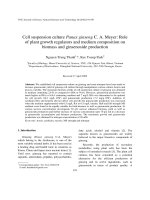

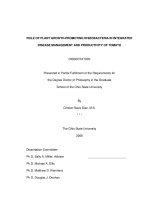
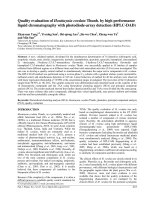
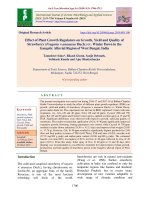
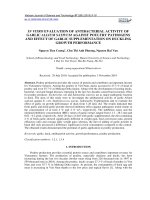
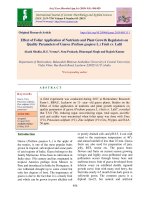
![Effect of different plant growth regulators on shooting of stem cuttings in dragon fruit [Hylocereus undatus (Haworth) Britton & Rose]](https://media.store123doc.com/images/document/2020_01/09/medium_isb1578564896.jpg)
